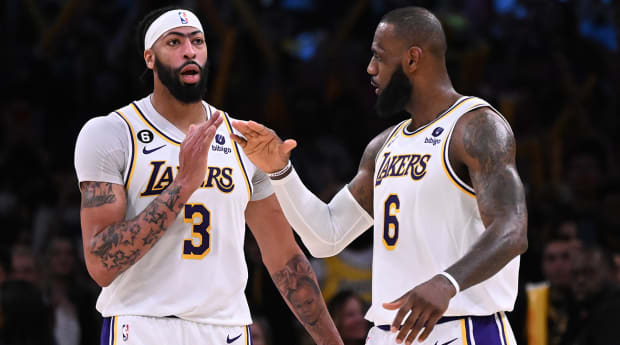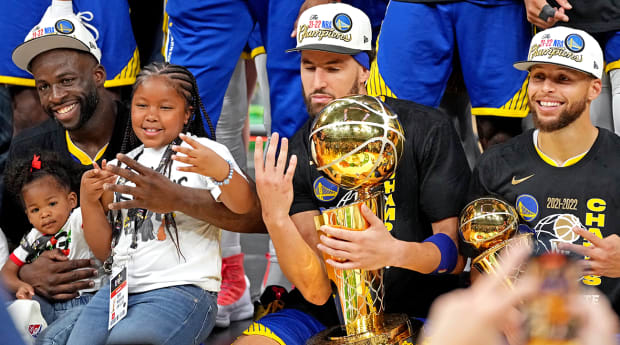Each morning, when NBA commissioner Adam Silver flips open his laptop and clicks on SI.com—for the purpose of this space we’ll assume the NBA commissioner’s go-to site for standings is, in fact, Sports Illustrated’s—what he sees makes him smile: a cluster of squads competing for playoff spots with no one separated from the rest. “It’s the most compact our standings have been literally in the history of the league,” says Silver. “And that’s something that we see from the league-office standpoint as very positive.”
Welcome to the new NBA, where a No. 8 seed can—and might—topple a No. 1 seed, and a half dozen teams (or more) will enter the playoffs with more than a puncher’s chance at a championship. Looking for superteams? Gone. Superstars? Evenly distributed. “This is the most competitive the league has ever been,” says Cavaliers president Koby Altman. Somewhere, David Stern is smiling.

Jayne Kamin/Oncea-USA TODAY Sports
Parity—er, “competitive balance”—began as Stern’s dream, born out of an admiration of the NFL model. In 2011, Stern initiated a lockout, one that came at a short-term cost—16 games of actual basketball plus years of fan backlash—but established the infrastructure of the NBA today. There was a repeater tax to dissuade owners from regularly exceeding the salary cap. And the “Rose Rule,” named after Derrick Rose, the ’11 MVP, allowed young stars to qualify for higher salaries, mechanically disincentivizing player movement. Silver, who succeeded Stern in ’14, flattened the lottery odds to curb tanking and created the play-in tournament to make postseason dreams more attainable. “There are other forces, societal forces outside of anything we could have negotiated,” says Silver. “But certainly this was the intent of the provisions we and the players association have been negotiating over the last two collective bargaining cycles.”
Indeed, there are other factors. Talent, fueled by increasing international growth, is better. Coaching is, too. Analytics have made teams smarter, more efficient and more capable of competing every night. Load management, a phrase the league would like to see vaporized from the NBA lexicon, has given lesser teams chances to steal a few games. Social media exposure, Silver says, has mitigated the off-court advantages once held by big markets. Says Silver, “Players see their opportunities coming more from their result on the floor than the particular size of the market they’re playing in.”
All this might have happened sooner, if not for an event league officials refer to simply as “The Spike.” In 2015, the NBA, preparing for an influx of cash from new television deals, proposed a steady increase in the salary cap, a smoothing, as opposed to an immediate jump. The union rejected it, the NBA declined to counter and the cap swelled from $70 million in ’15–16 to $94 million a year later, creating an unprecedented spending spree—which included the 73-win Warriors adding Kevin Durant. What followed was two anticlimactic seasons that saw a return to single-team dominance.
The Warriors are still benefiting: In 2019, Golden State traded Durant to Brooklyn for D’Angelo Russell, whom it later flipped to Minnesota for Andrew Wiggins, who spent last June smothering Jayson Tatum in the Finals. If Jonathan Kuminga, who was selected with the lottery pick the Timberwolves attached to Wiggins, develops, the Warriors will reap the rewards for years to come.

Kyle Terada/USA TODAY Sports
Parity is here now, though, and the NBA is thrilled. But are its broadcast partners? The league is neck deep in negotiations for new rights deals that could triple the $24 billion it collected in the last one. A competitive regular season is nice, but stars drive ratings—especially when they cluster, especially in major markets.
Since 2000 the NBA’s highest-rated games have featured super teams from Miami and Golden State or super markets Los Angeles and Boston. A barn burner between Cleveland and Memphis is fun in February, but the open question is whether networks are ready for a Midwest matchup in June. “This may surprise you, but they are,” says Silver. “When I first entered the league, we were much more dependent on individual markets for ratings. We’ve been making progress [to] become more NFL-like. The distinctions and the sizes of the markets make much less difference than the teams and the players that are participating.”
Silver isn’t ready to declare this season’s balance sustainable. “I’m encouraged by it,” he says. “But one year doesn’t make a trend. We need to look at the data.” And there are fears among top team executives that expansion could move the league backward. There have been no recent talks about expansion—Las Vegas, Seattle and Mexico City are routinely cited as league targets—but they could ramp up in the next few years.
“My bigger concern with expansion is dilution, as opposed to a lack of parity, because they’re two different things,” says Silver. “The dilution point doesn’t get as much attention. It always fascinates me that in a league of what most people would acknowledge are the 450 best players in the world or close to it, despite enormous amount of basketball being played on a global basis, that even once you take that pool—450 players—there are only so many true difference-makers who without one or possibly two, or maybe even three of those players, you don’t have a realistic chance of winning the championship. And so the more teams you add, the more diluted, potentially, the talent will be around the league. And then even going to the 450, if you add another 30 players, presumably those 30 players in an aggregate basis will be the next 30 best players in the world, not among the 450.
“On the other hand, this is a sport that is an Olympic sport. It’s truly played on every corner of the planet. And so I think over time, just think of when you and I first met, to the point now where you’re moving towards a third of our players were born outside the United States, so you have this enormous new pool of top-notch talent that’s constantly coming into the league.
“So do I think the league from a competitive standpoint could absorb two more teams? Absolutely. We’re not there yet. … But overall, my biggest concern is not an impact it would have on competitive balance.”
Still, the NBA’s system is solid, and there are more levers to pull. The league didn’t have any luck with a hard cap or an upper spending limit in its negotiations with the players union for a new deal, but in combating the few remaining free spenders (see Ballmer, Steve; Lacob, Joe), there are tools they took away. A second luxury tax “apron” was introduced. Teams that spend more than $17.5 million above the tax line will lose the ability to offer a mid-level exception. They will also be ineligible to take in more money than they send out in trades, making deals significantly more difficult. “One of our goals in this collective bargaining cycle is to create even better competition among the 30 teams,” Silver told SI before the agreement. “One of the ways is looking at the various tools that are available to teams that choose to go into the tax.”
For now, enjoy it. Stern’s dream has been realized, Silver’s efforts rewarded. The most unpredictable postseason in NBA history is coming. From the play-in to the playoffs it will be a free-for-all, and anyone can advance. Meet you in Cleveland.







